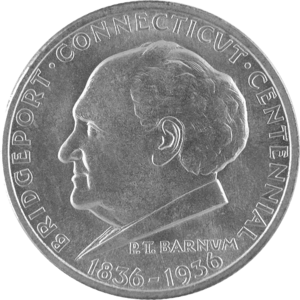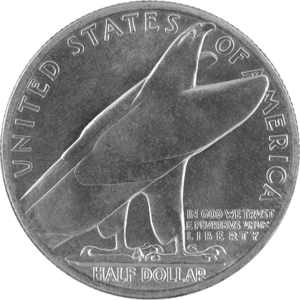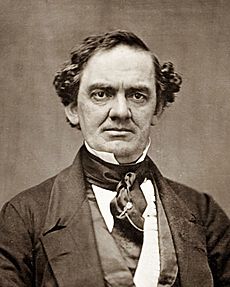Bridgeport, Connecticut, Centennial half dollar facts for kids
| United States | |
| Value | 50 cents (0.50 US dollars) |
|---|---|
| Mass | 12.5 g |
| Diameter | 30.61 mm (1.20 in) |
| Thickness | 2.15 mm (0.08 in) |
| Edge | Reeded |
| Composition |
|
| Silver | 0.36169 troy oz |
| Years of minting | 1936 |
| Mintage | 25,015 |
| Mint marks | None, all pieces struck at Philadelphia Mint without mint mark. |
| Obverse | |
 |
|
| Design | P. T. Barnum |
| Designer | Henry Kreis |
| Design date | 1936 |
| Reverse | |
 |
|
| Design | Stylized eagle |
| Designer | Henry Kreis |
| Design date | 1936 |
The Bridgeport, Connecticut, Centennial half dollar is a special coin made in 1936. It's a fifty-cent piece that was created by the United States Mint to celebrate Bridgeport, Connecticut, becoming a city 100 years earlier.
This coin was designed by Henry Kreis. One side of the coin shows the famous showman P. T. Barnum. He was a very important person in Bridgeport. He even served as the city's mayor and helped it grow. The other side of the coin features a cool, modern-looking eagle.
Bridgeport officials wanted this special coin to help raise money for their centennial (100-year) celebrations. At that time, the U.S. Congress often approved special coins for local events. The law to create the Bridgeport half dollar passed easily. The coins were sold to the public starting in September 1936 for $2 each. Even though they came out a bit late for most of the celebrations, they sold well. Today, these coins can be worth hundreds of dollars, depending on how good their condition is.
Contents
Bridgeport's History
Bridgeport is the largest city in Connecticut. It got its name from a drawbridge that locals were very proud of. The area was settled in 1639, but it didn't officially become a city until 1836. Many important people lived there, including Elias Howe, who invented the modern sewing machine.
One of Bridgeport's most famous residents was P. T. Barnum. He was a well-known showman, famous for his circus. Barnum was also the mayor of Bridgeport and served in the state's government. He is buried in the city. Barnum gave money to build a museum at Tufts University. As one writer said, "his greatest monument is the circus." The famous Ringling Bros. and Barnum & Bailey Circus continued until 2017.
In the 1930s, special commemorative coins became very popular with coin collectors. People could buy these new coins from the government for their face value. Then, they would sell them for a higher price to collectors. This made it seem easy to make money, which led to many new coin ideas being suggested in Congress. The Bridgeport coin was one of these ideas. The money raised from selling it was meant to help fund the city's centennial celebrations.
Making the Coin Law
To create the Bridgeport half dollar, a bill had to pass through the U.S. Congress. A senator from Connecticut, Augustine Lonergan, introduced the bill in March 1936.
At the time, some people in Congress were worried about how commemorative coins were being handled. Sometimes, coin issuers would make the same coin in different years or at different mints. This meant collectors had to buy many versions to complete a set, which could be expensive. Some coins were even bought up by just one dealer, making them hard to find and very pricey for collectors.
To fix these issues, the bill for the Bridgeport coin was changed. The new rules said:
- The coins could only be made at one mint.
- They had to be dated 1936.
- At least 25,000 coins had to be made.
- The money from selling the coins had to be used only for the centennial celebrations.
The bill passed both the Senate and the House of Representatives without much disagreement. President Franklin D. Roosevelt signed it into law on May 15, 1936. This meant the Bridgeport Centennial, Inc. organization could order the coins. Later, in 1939, Congress stopped the production of many older commemorative coins, including this one.
Designing the Coin
After the law passed, Bridgeport's mayor, Jasper McLevy, contacted the Director of the United States Mint, Nellie Tayloe Ross. He told her that Henry Kreis, who had designed another Connecticut coin, would sculpt the Bridgeport coin. The mayor also sent sketches of the proposed design. He explained that P. T. Barnum was chosen for one side because he had given Seaside Park to the city and helped develop East Bridgeport.
Before a coin design is approved, it usually goes to the Commission of Fine Arts. This group gives advice on public artworks, including coins. The commission looked at Kreis's designs and generally liked them. They suggested moving the words "LIBERTY" and "IN GOD WE TRUST" to the back of the coin. This would make more space on the front for Barnum's portrait and allow the word "CONNECTICUT" to be spelled out fully.
The revised designs were approved. By August 1936, the final models were ready. These models were then used to create the special tools needed to strike the coins.
Coin Design Details
The front (obverse) of the Bridgeport half dollar shows a detailed picture of P. T. Barnum's head. Many people have commented on this portrait. Some say it looks a lot like Barnum, but others felt it was just "average" for the talented artist, Henry Kreis.
Some coin experts have joked that choosing Barnum for the coin was fitting because of his famous saying, "There's a sucker born every minute." They thought this might apply to coin collectors in the 1930s who were eager to buy new commemorative coins.

The back (reverse) of the coin features a unique, modern-looking eagle. This eagle design received mixed reviews. Some people in the art world loved it, calling it "modernistic." However, many members of the public found it confusing and didn't immediately recognize it as the national bird. One coin dealer even joked that it looked like an "airplane" or a "shark" and that it seemed to be laughing.
Despite these different opinions, many experts agree that the coin has a strong "Art Deco" style. The design is considered a success because Barnum's portrait is accurate, and the eagle is stylish and inspiring. One art historian even said it was one of the most successful commemorative coins ever made in the U.S. He praised the bold design of Barnum and the "thrusting eagle." The historian also suggested that Kreis might have chosen the eagle because he couldn't find another good Bridgeport-related symbol for the back of the coin.
Making and Selling the Coins
In September 1936, 25,015 Bridgeport half dollars were made at the Philadelphia Mint. A small number were kept for testing later. The coins were sold for $2 each, mainly through local banks in Bridgeport. People could also order them by mail.
Even though many of the centennial celebrations had already happened, the coin sold well to both the public and collectors. There were still several thousand coins left unsold. These were then given to the Bridgeport Community Chest, a charity group. They sold the remaining coins in bulk to coin dealers for a small profit.
For many years, these coins were available from dealers. In the 1950s, one dealer had about a thousand of them. Rolls of 20 coins were sold at coin conventions for a long time.
The value of the Bridgeport half dollar has changed over the years. In 1940, an uncirculated (like new) coin was worth about $1.50. By 1960, it was $12. By 1985, it jumped to $250! Today, depending on its condition, the coin can be worth between $120 and $300. An especially perfect coin sold for $1,880 in 2015.



